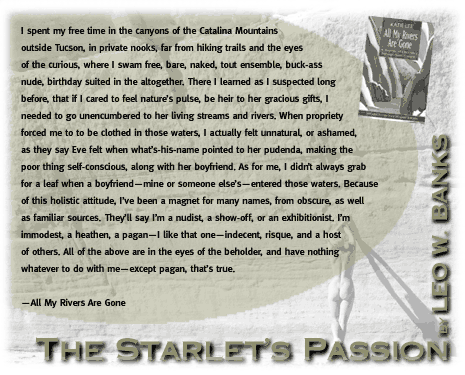
JEROME--KATIE LEE'S considerable passion is never far from
the surface. It shows when her blue eyes widen in a rage, and
in the tenor of her voice when she takes off on one her rants
against greed or government bureaucrats. She has a theatricalings
an arm toward the big window in her study, beyond which lay the
pink and purple hills of Jerome, in central Arizona's Verde Valley.
"I suppose it's strange that I'd wind up here in an old
mine town," she says, eyeing the gouges in the ground that
yielded one of North America's greatest lodes of copper: "Look
at what they've done to the earth. My earth."
But Jerome, population 500, is actually the perfect place for
Lee. The mining has long since ended, and the town is now home
to artists, longhairs, rednecks, witness protection graduates
and fools bold enough to cling to their own ways of thinking and
doing.
 The buildings hang precariously, and it seems, impossibly, against
the steep slopes of Cleopatra Hill. Some have even slid a few
feet or more. But so far they've hung on, and so has Lee, a former
Hollywood starlet of some note and a folk singer who recorded
eight albums. At 79, she's also an author and environmental activist
seeking to convince the world that Glen Canyon Dam on the Colorado
River needs to come down.
The buildings hang precariously, and it seems, impossibly, against
the steep slopes of Cleopatra Hill. Some have even slid a few
feet or more. But so far they've hung on, and so has Lee, a former
Hollywood starlet of some note and a folk singer who recorded
eight albums. At 79, she's also an author and environmental activist
seeking to convince the world that Glen Canyon Dam on the Colorado
River needs to come down.
It has been her cause, her defining purpose, for more than three
decades. The anger that drives her is like fuel. She has used
it to produce a book, 35 years in the making, that's part river
history, love story, political polemic and personal narrative
of her pre-dam trips down the Glen, which corkscrews across 170
miles of southern Utah into Arizona.
All My Rivers Are Gone (1998, Johnson Books, Boulder,
Colorado) veers from heartfelt and well-written descriptions of
a mystical place now gone, and the awakening its beauty engendered
in her, to maddeningly emotional screeds about whoever or whatever
aggravates her, especially those behind the dam's construction.
"Humans have a genetic mania to destroy all the sanctuaries
that feed their souls," Lee writes. "I don't want to
be part of the human race when I see pimps in government and the
whores who do their bidding. I'd rather be a coyote."
The dam was built in the early 1960s by the U.S. Bureau of Reclamation,
a division of the Interior Department, to provide electricity
for Western cities, and to store water in the desert. It created
Lake Powell, the north-central Arizona town of Page on its shores,
and a substantial industry in boating, fishing and water sports
that draws some three million visitors a year.
But to Lee and others, this 710-foot-high, $300 million mass
of concrete represents the unnecessary taming of the Colorado
River and the resultant degradation of the Grand Canyon, which
connects with Glen. They also argue that it's a symbol of the
triumph of politics over common sense, and most significantly,
the destruction of one of America's most beautiful places.
David Brower, founder of the Sierra Club, says dismantling the
dam would set in motion "the greatest restoration project
in our nation's history.
Few environmental issues are richer in irony and political gamesmanship
than the decision to build this dam. Its origins are in the long-running
feud between Western states over use of Colorado River water.
The bickering led to passage, in 1922, of the Colorado River
Compact, which allocated water between the upper basin states
of Utah, Wyoming, Colorado and New Mexico, and the lower basin
states of California, Arizona and Nevada. The agreement paved
the way for the federally funded Boulder (now Hoover) Dam Project
of 1928.
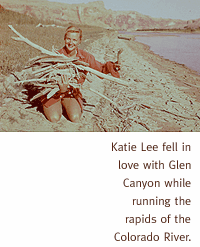 But the upper basin states, knowing they had to better manage
their resource or lose it to the thirsty lower basin, pushed for
and got passed the Colorado River Storage Project of 1956, which
provided federal money to build several dams and irrigation projects.
But the upper basin states, knowing they had to better manage
their resource or lose it to the thirsty lower basin, pushed for
and got passed the Colorado River Storage Project of 1956, which
provided federal money to build several dams and irrigation projects.
Among them was a dam on the Green River in Echo Park, Utah. But
the Sierra Club, then a fledgling group led by Brower, fought
the proposal because it would back water up into Dinosaur National
Monument.
Brower told the government that Glen was a better site for a
dam, and he wouldn't oppose plans to build there if the Echo Park
project were dropped. He essentially traded Glen Canyon away.
Few of those involved in the decision had ever seen the remote
canyon, with its rock cathedrals, massive cottonwoods and pristine
waterfalls, and had no idea of its majesty. In the years since,
Brower has expressed profound regret, and reversed himself.
He has been joined by a chorus of others. Just about every politician
who favored the dam has acknowledged the mistake, including Barry
Goldwater, who said if he could take back a single vote in his
long career, it would be the one he cast in favor of the dam.
"There wasn't much of an environmental movement then,"
says David Wegner, vice president of the Glen Canyon Institute,
a group dedicated to seeing the dam come down.
"With the help of a few key senators and congressmen, the
government forced this through with almost no public input. A
few people like Katie Lee and others were crying, but they weren't
enough to sway the vote. There's no chance on God's green earth
that dam would be built today."
Part of what bothers Wegner, a biologist who worked for the Reclamation
Bureau until quitting in 1996, is the damage the dam has done
to Grand Canyon.
It traps sediments behind it, so no life-giving nutrients flow
downstream. And the water that makes its way below Glen, once
warm and muddy, is so icy cold that two species of native fish
have already vanished from Grand Canyon, and another is close
to going.
Wegner adds that the dam provides only three percent of the electrical
needs of Arizona, New Mexico, Colorado and Utah, which could be
easily made up from other sources.
As for water storage, its primary purpose, he says the dam is
a failure. Some 8 percent of the annual allocation that flows
south every year is lost in evaporation from the surface of Lake
Powell.
"So it's a water loser, not a water saver," says Wegner.
"This began as a political dam, and it's a political dam
today."
But proponents say it would be equally foolish to tear it down.
How do you dismantle a massive dam? Could it be done without
catastrophic flooding? Would the flora and fauna regenerate? How
long before the bathtub ring left by the water vanished, and the
pink sandstone showed again?
Is there any guarantee that lower basin states will receive their
agreed-upon water allotment in drought years?
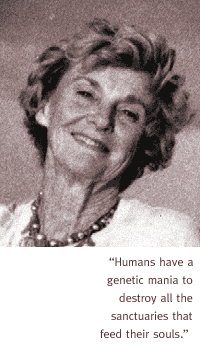 Wegner says that if the dam were removed, the downstream water
requirements would not be met only 1 percent of time. But that
1 percent might require rationing in upper basin states, whose
leaders would raise a powerful stink against that.
Wegner says that if the dam were removed, the downstream water
requirements would not be met only 1 percent of time. But that
1 percent might require rationing in upper basin states, whose
leaders would raise a powerful stink against that.
What would become of Page, the growing town of 8,500 at the dam
site?
Environmentalists claim the water sports now enjoyed on Lake
Powell would be replaced by different types of recreation--river
running, canoeing, mountain biking--and that Page could become
a world center for the restoration of rivers.
But few in town believe that. They say their community would
dry up without the water Lake Powell provides for household use.
Water-based businesses would close. The marinas, too. And tourism,
the number one industry, would vanish.
"Eventually we'd become a great ghost town," says Joan
Nevills Staveley, executive director of the Page-Lake Powell Chamber
of Commerce.
And for what, she wonders?
"The silt that has accumulated in Glen and its side canyons
won't wash away when the water is gone," says Nevills-Staveley,
whose father, Norm Nevills, was the first commercial river runner
on the Colorado. "So the canyon you see in those beautiful
pictures is a place that can never be again, I miss the Glen.
I fought against it, too. It was a real treasure, but Katie and
the others need to move on."
If momentum exists to remove the dam, as opponents insist, it
has yet to penetrate the political veil. Not a single elected
official has announced in favor of the idea.
AT THE TIME Lee discovered Glen, she was living in Hollywood,
and hating it. She grew up in Tucson, and her father, a contractor,
built the Lodge on the Desert. As a college kid, Lee played her
guitar and sang for tuition money at weekend gigs in the Pioneer
Hotel, and in 1948 headed to California to become rich and famous
as an actress.
She appeared in a few movies, worked as a radio actress, sang
sweet folk songs, and landed parts in some of the first TV shows
ever made--The Great Gildersleeve, Armchair Detective,
The Railroad Hour and others. To pay the bills, she worked
as a part-time secretary to Mary Pickford Productions.
None of it brought much happiness. "I spent most of my time
holding back insults to idiots," says Lee.
She was, by her own admission, comically naive about the world
at large. In All My Rivers, she tells a coming-of-age story
about her initiation into the sometimes twisted machinations of
American politics in 1950.
She was working and hanging out with other Hollywood entertainers.
Lee knew all the famous folk singers of the time, many of whom
gathered every so often to play guitar and sing. The parties were
called hootenannies, or hoots for short.
At the same time, the House Un-American Affairs Committee, led
by Wisconsin Sen. Joe McCarthy, was beginning its work of rooting
out communists in government and entertainment. Among those called
to testify before the committee were singers Burl Ives and Josh
White, two of Lee's contemporaries.
Lee writes that she found the whole McCarthy matter incomprehensible,
and decided to deal with it by phoning up the FBI and assuring
them she was just a singer, uninterested in politics, and as American
as can be. She left her number and invited the agent to check
her background any time.
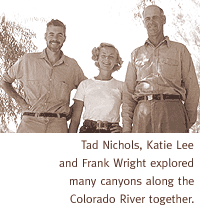 Some days later, Lee's phone rang. The same FBI agent was calling.
"You remember talking to me a while back?" he said.
Some days later, Lee's phone rang. The same FBI agent was calling.
"You remember talking to me a while back?" he said.
"I do," she said, taken aback at the call.
"I understand there's to be a party. I believe you call
them hoot...hootin...
"Hootenannies."
"Yes...in Topanga Canyon this weekend. Are you planning
to go to that, ah, gathering."
She felt the hair rise on her neck. She asked if the agent was
going to tell her she couldn't go.
"No. Oh, no, Miss Lee, not at all. Of course you can go.
In fact, we hoped you were. We just want you to tell us who's
there."
Lee refused to be an informer. When she told her pal, singer
Woody Guthrie, what had happened, he said, "You tell the
Fellatio Bru-ho of Investigation to go to hell. Sing your songs
to the people, Kaylee, and heal their hurts by telling them how
it looks to you."
For the first time in her life, Lee sniffed what she describes
as "the evil in government," and started down the road
to becoming an activist.
Meeting the Colorado River and Glen Canyon solidified the process.
Lee was introduced to the river in 1953, when she became only
the third woman in history to run all of its rapids through the
Grand Canyon. The following year she ran the river through Glen.
With commercial river runner Frank Wright and Tucson photographer
Tad Nichols, Lee returned 15 times over the next 10 years, often
paying her way by singing folk songs for tourists.
Even then, Glen was largely virgin territory, so remote it was
unknown to all but a few miners and adventurers. Lee and her friends
probably knew it best. They explored many of its 200 side canyons,
naming some 25 of them, crawled through ancient Indian caves,
swam naked in icy pools, climbed cliffs of Navajo sandstone, and
camped and sang on moonlit sandbars.
In those trips Lee says she fell completely for Glen, and that
love changed her life. It taught her the significance of intimacy
as a performer, and the transforming power of sanctuary.
It also cleared Lee's head, allowing her to see how unhappy she
was in Hollywood, and to heed the advice of friend Burl Ives to
take her songs on the road as a touring singer.
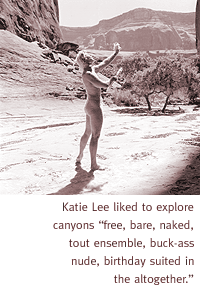 From 1954 to 1962, she played some of the country's toniest nightclubs,
from the Blue Angel and Downstairs at the Upstairs in New York,
to opening night at Chicago's Gate of Horn. In between she squeezed
in appearances on the Tonight Show with Jack Parr and Dave
Garoway, radio spots with Studs Terkel, and benefits with Harry
Belafonte.
From 1954 to 1962, she played some of the country's toniest nightclubs,
from the Blue Angel and Downstairs at the Upstairs in New York,
to opening night at Chicago's Gate of Horn. In between she squeezed
in appearances on the Tonight Show with Jack Parr and Dave
Garoway, radio spots with Studs Terkel, and benefits with Harry
Belafonte.
But she'd switched from sweet cowboy ballads to songs she wrote
herself protesting the dam.
On January 21, 1963, the day the Reclamation Bureau closed the
diversion tunnels, slowly filling the canyon with water, Lee began
living an exquisitely personal nightmare that continues to this
day.
"Once a year I'd go back to watch the desecration, to see
my canyon destroyed under that stinking puddle," says Lee.
"I don't know why I went there because all I did was cry.
After a few years I stopped, and I won't go back until Glen becomes
a sanctuary again. No motor should ever whine in that place. It
should be 177 miles of absolute peace and quiet. It'll be the
only place left in the U.S. like that."
Nichols, now 85, remembers the sense of loss he felt at the demise
of Glen Canyon, but says it was particularly hard on Lee, a friend
since college.
"Having that lake come up really affected her, and I know
she can't forget it," says Nichols, who is putting together
a book of his Glen Canyon photographs. "I remember that first
trip we took in 1953. Boy, that did her a lot of good. I really
admire what she's doing, but she turns a lot of people off with
her swearing.
She can be quite prolific with foul language."
Explains Lee, "I never swore when I was on the river. Now
that my canyon is gone, I swear again."
THESE DAYS LEE spends much of her time making appearances
to sing her river songs, read passages from her book and fan the
flames of anti-dam sentiment. She writes in a cramped basement
room of her hillside home. A steer's skull adorns the wall over
the entrance, and a rifle rests on the table next to her computer.
Lee and her companion of 19 years, Joey, a silver-haired Australian--"I
picked him up down there while I was hitchhiking around the world"--use
the gun to control the squirrel population on their property,
and occasionally she cooks the meat.
"Those little bastards are everywhere around here, but they
taste good," says Lee, who has never been particularly accomplished
at subtlety.
Her first book, published in 1976, was called Ten Thousand
Goddam Cattle. And hanging on the wall of Lee's study is a
picture of her taken recently for a river guide's magazine. With
her arms folded across her chest, she's holding a monkey wrench
in one hand and a stick of dynamite in the other.
The pose is a reference to The Monkey Wrench Gang, a 1975
novel in which a band of rebels plot to blow up the Glen Dam.
Back in the late 1970s, its author, the late Edward Abbey, read
the first draft of Lee's book, then a novel, and convinced her
to re-write it as a personal story based on the journals she kept.
Abbey saw that the strength of her story came from the power
of Lee's personality, the same mix of energy and raw emotion that
made her the country's top female folk singer in the early 1960s,
and could've led to fame and wealth as an actress if she'd stayed
in Hollywood.
But never in the years since leaving California has she looked
back and thought she made a mistake--even though she's just as
certain that if she stayed, she'd now be famous, with a long list
of movie credits, maybe a mansion on the beach.
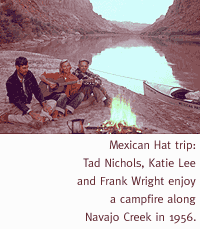 "I never failed to do anything I set out to do," says
Lee, with matter-of-fact certainty, "so I would've succeeded
at that, too."
"I never failed to do anything I set out to do," says
Lee, with matter-of-fact certainty, "so I would've succeeded
at that, too."
"But wouldn't it be nice?" she's asked.
"Oh, God no. Who needs it?" Lee is exasperated by the
very thought. Then, just as quickly, she tears up.
"I never would've met the Glen. Think what I would've missed--all
that incredible beauty, listening to the rocks, feeling the sun
on my back, slipping into a cold pool. I never stepped in front
of a spotlight and got that feeling."
But one thought does dry her tears and return joy to her face:
Lee's firm belief that the dam's days are numbered--by nature,
not man.
She notes that during the big floods of 1983, rising water yanked
house-sized chunks from the dam's spillways, and before long,
perhaps tomorrow, perhaps next year, she believes the whole shebang
will give way.
"They're so fucking stupid they have that thing within five
feet of the top right now," says Lee. "I tell you, sweetie,
Mother Nature is going to blow that sucker to kingdom come, and
the wreck-the-nation bureau is going to be so frustrated because
they can't stop her, they can't arrest her and they can't lock
her up.
"When that day comes, if I'm still around, I'll get in my
car, go there as fast as I can, jump up and down, take pictures
and scream, 'You assholes! I told you so!' And if they try to
repair it, I won't let them. You can believe I'll have a lot more
help this time."

|





